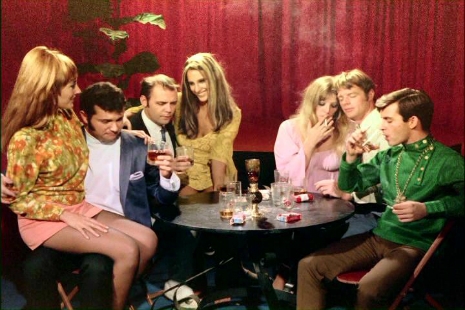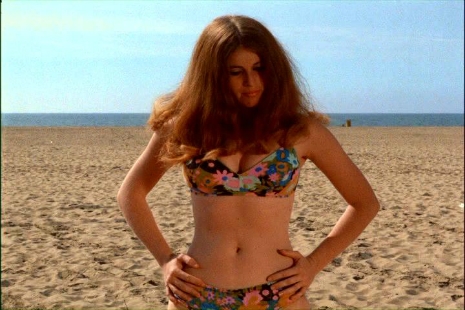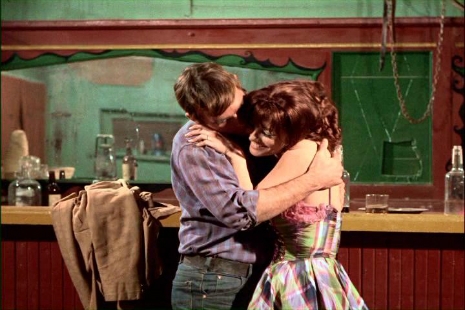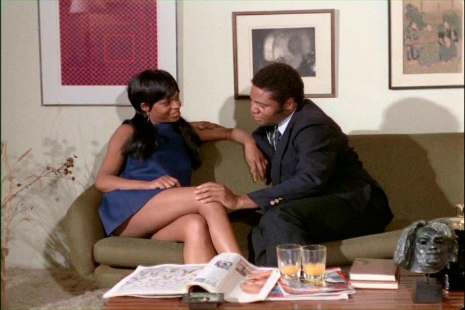
This is a wondrous age we live in. Films that have languished in obscurity, rotting away in assorted attics and storage units are starting to resurface, all after being tossed off as lost. It’s a weird film lover’s dream and adding to the growing list are not one but three titles, all connected to the Godfather of Gore and cardinal in the holy church of exploitation cinema himself, Herschell Gordon Lewis. Thanks to the hardworking folks at Vinegar Syndrome, not only do we have access to the Ecstasies of Women, Linda & Abilene and Black Love, but we have access to them restored and looking more gorgeous then they have a right to on both DVD and glorious Blu Ray as The Lost Films of Herschell Gordon Lewis.
The high definition sleaze proceedings begin with The Ecstasies of Women, a 1969 light-as-a-feather but stiff-as-a-bourbon-on-the-rocks confection that just oozes late 60’s swank. A bachelor party for Harry (Walter Camp) is in full swing at a topless revue club, complete with a snarky but flirty waitress who greets the groom-to-be and his companions with, “How’s the doomsmen and his executioner?” Instant awesome.

Even better is some of the commentary towards the two pulchritudinous lovelies gyrating on stage. “They must have ball bearings for ball joints!” Turns out ole Harry makes his bread by selling lingerie, presumably door-to-door, to ladies across the land. In a gin stooped, horny daze, our hero starts daydreaming about all of the sweet memories that have unfolded in his bachelor pad/houseboat. The first dreamy flashback, complete with little charming and ethereal sound effects accompanying it, involves a semi-downtrodden but lovely brunette Annette (Jeanette Mills). Annette, a permanent tourist, ends up falling for Harry’s come-ons, which are on the Tillamook side of cheese.
After some heavy petting in Harry’s golden gas guzzler of the gods, they head back to the houseboat, where Annette models some of his bread and butter. Ignoring the uncleanliness of it all, the two hit it off biblically, complete with lots of leg and semi-chaste haunch shots, with a soundtrack of lounge music and dubbed over moaning.
It’s not long after that we get Harry’s next flashback, this time napping on the beach, only to be interrupted by a beach bunny, Sandy (Vincene Wallace), whose love of wheat germ & clean living is matched only by her abrasive nymphomania. Such a combo can be scary if we’re talking about the winsome physical charms of Taft but luckily for Harry, Sandy’s blonde, busty and willing. Cue in, you guessed it, more groovy music and dubbed in moaning.

Harry’s houseboat, which features such nice decorations as a big sign that proclaims “This is not the Mayflower but many broads have come across in it!” Nothing says class like referring to women as broads. Quick lesson, unless you’re the living reincarnation of James Cagney circa Public Enemy, just say no. His next dreamy flashback starts with him picking up a comely hitchhiker, Philomena (Sharon Matt). Jail bait on a stick, Phil all but tells him that she is fifteen but quickly backtracks when he starts to (understandably) freak out. Fellas, here’s another tip, if you pick up a young looking girl who is dressed in a schoolgirl uniform and you’re NOT in an Aerosmith video, just assume she’s jail bait and get out of dodge.
But Larry’s the kind of guy who likes to live it up Jimmy Page style and brings young Phil to his boat of wood-paneled lust. Before the film turns into a sheer 60’s negligee version of All the Girls I’ve Loved Before, Harry’s loins and heart are soon sorely tempted by one of the girls at the Revue and with a name like Summer Frenzy (Bonnie Clark), who could blame him?
Out of the three films, The Ecstasies of Women is the most fun with the best zingers, lots of great colors, gorgeous ladies and warped, horny logic that lies only in that special realm known as sexploitation. The trailer that accompanies is it equally fun, with Harry being described as a “professional lovemaker.” I hear the pay is bad, but the benefits are quite cherry.
After that, is 1969’s Linda & Abilene, one of the very few hybrids of the western genre with sexploitation. While the titular Linda (Roxanne Jones) romps with a macho cowboy during the opening credits, the film itself begins with a funeral. Young Abilene (Sharon Matt, again) and her brother Todd (Kip Marsh), are left orphaned as they bury their parents. Dealing with their grief, they both press on, as the young adults take care of their family’s land and humble home.

Their healing path soon takes a weird turn after Todd catches his sister skinny dipping, unraveling a whole slew of hormones and urges towards her. Fate would have it that Abilene is also having some similar feelings. Faster than you can say “Jesus, no,” the twain do meet and meet again, making one wonder if anyone sitting in the grindhouse audience was actually aroused or too busy being squicked out by the family love gone way the hell too far.
Todd starts to feel guilty, conveniently after canoodling with her around eleventy times, and runs off to town to get a breather at the local bar. (He should have ran to a local church to thank god that she wasn’t pregnant with their two headed love-spawn.) An hour later after her brief appearance in the opening credits, Linda shows up and is instantly smitten with handsome and confused Todd. When she inquires about Abilene, Todd lets it slip that she is all alone on the farm, all within ear shot of the superbly greasy Rawhide (Tom Thorn). Linda gets to know Todd better, giving Rawhide the chance to travel to the family farm. Pretending to be a hungry wanderer, he presses a very scared Abilene into cooking for him, which she does. Praising her cooking skills, he then proceeds to rape her.
Finally coming home, Todd finds out what happened and goes on a rampage. (Though never providing us the desired bon mot of “Nobody gets to have sex with my sister except me!”) While he is out searching for Rawhide, Linda makes her way to their home. Initially looking for Todd, she ends up comforting the traumatized Abilene. In a bizarro world move, Linda ends up seducing Abilene, which is a tactic I don’t think most would recommend when trying to help victims of rape. Todd finally finds Rawhide and the inevitable showdown begins.
Linda & Abilene is more of a fascinating curio than a film. As a movie, the pacing is way too slow with a whole lot of drag. For a film that should have been 70-75 minutes max, the running time is 92 minutes. History wise, it is more interesting. In addition to the genre hybrid, Linda & Abilene was filmed on location at the infamous Spahn Ranch. Even more so, Lewis recalled some of the seemingly harmless hippie kids hanging around, watching and giggling while some of the saucier scenes were filmed. It’s not often one can have a nice Manson family tie-in with their exploitation westerns.
Last but not least is Black Love. To give you an idea of the proceedings, here’s a sample of the opening voice over; “Black Love is not an erotic sex film. It’s rather a study of an important aspect of the black experience-the act of making love.” Never mind the fact that lovemaking is a pretty important experience for all races, there is one very important nugget of truth in that opening statement. Namely, that it is most definitely not an erotic sex film. It’s a sex film alright, sans any glue shots, but it is about as erotic as a mule kicking you in the head.

Presented in the loose, faux-documentarian spirit of the old white coaters from the late 60’s/early 70’s, the first example of “black love” is how children first learn about it. The narrator mentions it is often through stories they hear, experimenting when they are older and watching adults…..what??? A bored teenager catches two adults in the backseat of a car in the middle of the day in some industrial looking parking lot. It just gets worse as a little girl walks in on her parents. (Thank god that it is obvious that the kids were not in the same room as the in flagrante delicto action.) Instead of vomiting, running and screaming, which is what 99% of kids of all races would do, she stays looking surprised and giggling. I instantly need therapy.
It goes on from there, examining the ideal black couple and people dancing at a predominantly African-American club. Black Love toes this strange line of trying to sound progressive, yet is interspersed with assorted commentary about the assorted physical differences that skirts up to the county of racist. It would actually be racist except a lot of the traits noted about “black love” (save for the aforementioned creepy watching bit) could be said about all races. At one point, the narrator notes the physical differences of each club goer. Turns out black people can be short, tall, thin, large, some darker skinned and others lighter skinned and some even wear varying fashions…just like every other race.
On one hand, Black Love is kind of horrible, but on the other hand, it’s horrible-ness is something so strong that it could unite all races closer together. It is amazing that this film was even found, since out of the three formerly-lost HG Lewis titles, this is the one that drummed up the most curiosity. Lewis’ own back and forth about even being associated with it has given it, inadvertently, added mystery. It is a relic of a time when both sexual and racial prejudices were being actively challenged. Kind of sad that thirty plus years later, we are still having these same prejudices. It makes anyone with a soul and an IQ over toast frustrated and angry.
The Vinegar Syndrome have done an absolutely luscious job releasing and restoring The Lost Films of Herschell Gordon Lewis. The first two films especially look so gorgeous, with the use of color really popping. Then there’s the great cover art, well researched liner notes courtesy of Casey Scott and a trailer for each title. They might not be the best examples of Lewis’ work, but they are part of a fascinating director’s filmography. This release is another A+ mark in the often underlooked field of film preservation.